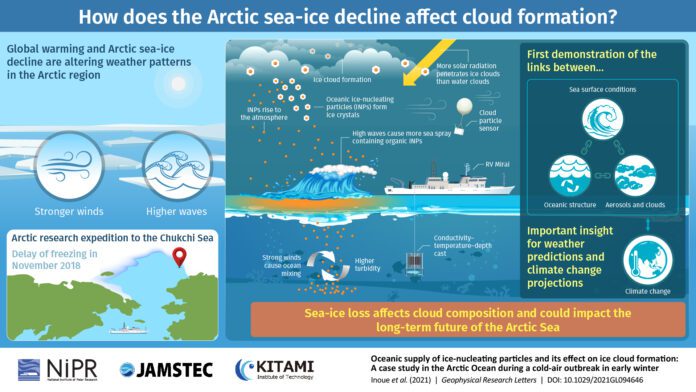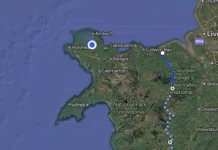How Do Higher Waves Cause More Ice Clouds? Research Expedition into Arctic Sea Explains
Scientists explain the peculiar interplay that exists between sea-ice decline, wave height, and ice cloud formation over the Arctic
Global warming is causing a rapid decline in sea-ice area, which affects weather patterns and, surprisingly, increases wave height in the Arctic. In a new study, Japanese scientists analyzed data from a 2018 research expedition into Chukchi Sea to demonstrate the peculiar link that exists between organic particles on the ocean surface, tall waves, and the formation of ice-containing clouds. Their results pave the way for more accurate climate change and sea-ice models.
Some of the most well-known and feared aspects of climate change are its potential effects on weather patterns and how this could accelerate the melting of natural ice. Research has already proved that the area of sea-ice in the Arctic is rapidly declining due to global warming, and that temperature and moisture content across the Arctic have changed substantially. Unfortunately, understanding exactly how these changes affect cloud formation in the region is very challenging, and cloud composition and phase are important aspects to consider in predictive numerical models.
In a recent study published in
Geophysical Research Letters, a team of scientists led by Dr. Jun Inoue of the National Institute of Polar Research, Japan, sought to answer a peculiar question: can higher waves in the Arctic Sea promote the development of ice-containing clouds? This question may seem strange at first, because most people would not have fathomed that a link could exist between those two natural phenomena. However, as the findings of this study indicate, it’s likely that there is one.
The field data used in the study was gathered in November 2018 during an expedition to the Chukchi Sea in the Arctic region aboard RV Mirai, a Japanese research vessel. Previous studies in the area had revealed that the sea-ice decline in the Arctic led to more frequent active weather systems, stronger winds, and taller waves. The research team suspected that these factors could affect cloud formation and composition because crashing waves and strong winds can cause organic particles on the sea surface to become dispersed through the atmosphere in the form of sea spray. Once these suspended organic particles reach an altitude high enough, they act as “seeds” that facilitate the formation of ice crystals, earning them the name of “ice-nucleating particles” (INPs). These ice crystals keep growing by freezing the surrounding water droplets, thereby forming what’s known as ice clouds.
To prove this hypothesis, Dr. Inoue and his crew on the RV Mirai periodically deployed various measurement instruments at key locations in the Chukchi Sea over the course of 12 days. Cloud particle sensors were balloon-launched from the ship to analyze the phase of clouds, ambient aerosols were regularly sampled on board for chemical analysis, and wave height and wind speed measurements were constantly made. Moreover, the researchers conducted turbidity measurements from different depths to clarify the relationship between weather, oceanic conditions, and organic matter.
After analyzing all the gathered data, the scientists managed to paint a clearer, evidence-supported view of the situation. “Chukchi Sea is relatively shallow, with a mean depth of only 40 meters. There, a mixed ocean layers develops and taps into the seafloor, which provides a reservoir of INPs that get lifted by turbulent kinetic energy and active biology,” explains Dr. Inoue, “Sea spray induced by strong winds and high waves brings these INPs to the atmosphere, promoting the formation of ice clouds”. He adds that this is one of the first papers to simultaneously link oceanic structure, sea surface conditions, and aerosol and cloud characteristics.
The insight gained from this study is very important if we are to accurately predict the effects of global warming on the Arctic. Ice clouds reflect much less shortwave solar radiation than water clouds, and thus the phase of clouds greatly affects the surface heat budget of the polar regions. They may also increase the amount of snowfall, which in turn positively affects sea-ice formation. “Understanding the relationship between cloud formation and the new sea state originating from the recent Arctic sea-ice decline is critical for skillful weather and sea-ice forecasts, as well as future climate projections,” highlights Dr. Inoue. Let us hope further studies in the Arctic allow us to elucidate all the fine details and hidden interactions that dictate the weather so that the consequences of climate change don’t catch us off-guard.
***
Reference
Title of original paper: Oceanic supply of ice-nucleating particles and its effect on ice cloud formation: A case study in the Arctic Ocean during a cold-air outbreak in early winter
Journal: Geophysical Research Letters
About National Institute of Polar Research, Japan
Founded in 1973, the National Institute of Polar Research (NIPR) is an inter-university research institute that conducts comprehensive scientific research and observations in the polar regions. NIPR is one of the four institutes constituting the Research Organization of Information and Systems (ROIS) and engages in comprehensive research via observation stations in the Arctic and Antarctica. It strives to promote polar science by soliciting collaboration research projects publicly, as well as by providing samples, materials, and information. NIPR plays a special role as the only institute in Japan that comprehensively pursues observations and research efforts in both the Antarctic and Arctic regions.
About Dr. Jun Inoue from National Institute of Polar Research, Japan
Jun Inoue obtained a PhD in Environmental Earth Science from Hokkaido University, Japan, in 2001. He is currently affiliated to the National Institute of Polar Research, a member of the Research Organization of Information and Systems, Japan. His research interests lie on atmosphere–ice–ocean interactions centered on meteorology in relation to global warming and climate change.
Funding information
This study was supported by JSPS KAKENHI (grant numbers JP18H03745, JP18KK0292, JP19H01972) and the Arctic Challenge for Sustainability Project (ArCS) (grant number JPMXD1300000000) of the Japanese Ministry of Education, Culture, Sports, Science and Technology.
Help keep news FREE for our readers
Supporting your local community newspaper/online news outlet is crucial now more than ever. If you believe in independent journalism, then consider making a valuable contribution by making a one-time or monthly donation. We operate in rural areas where providing unbiased news can be challenging. Read More About Supporting The West Wales Chronicle


























